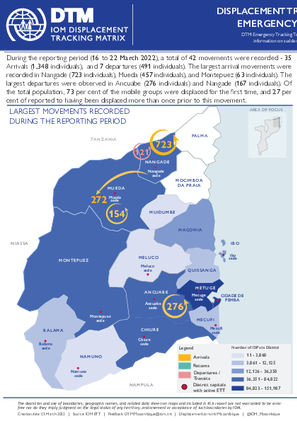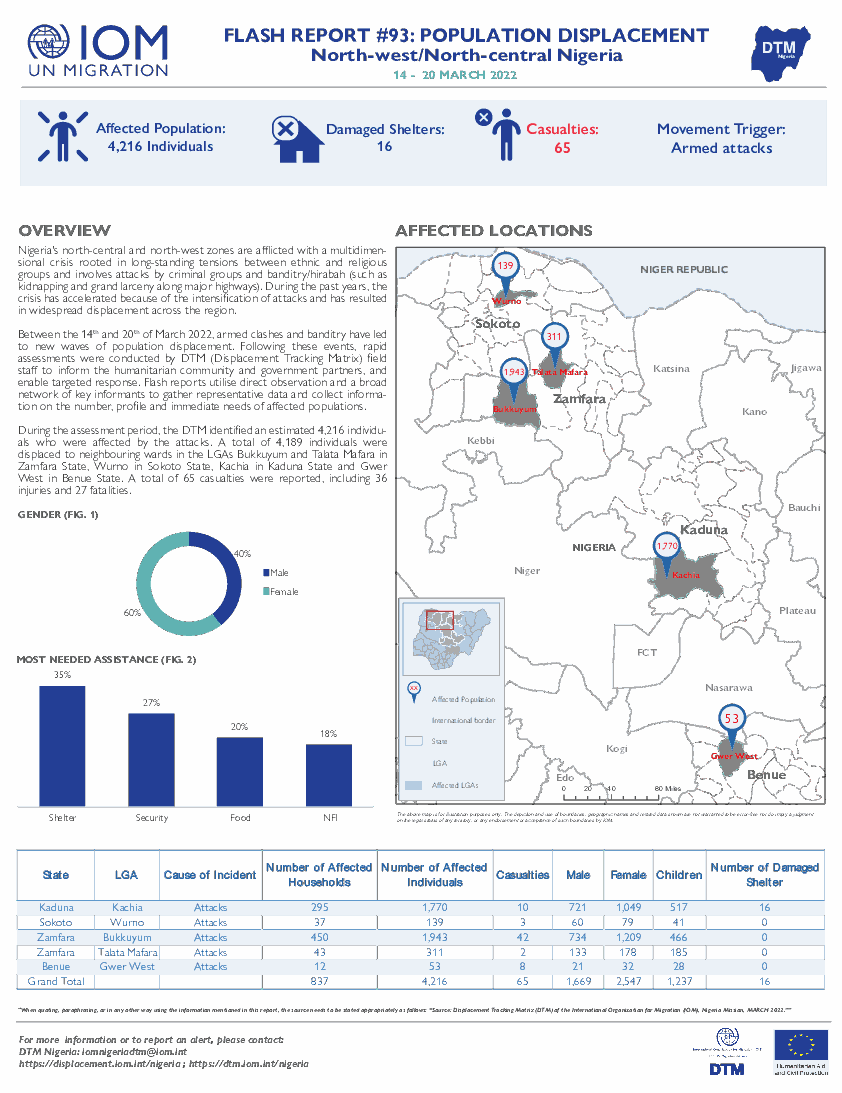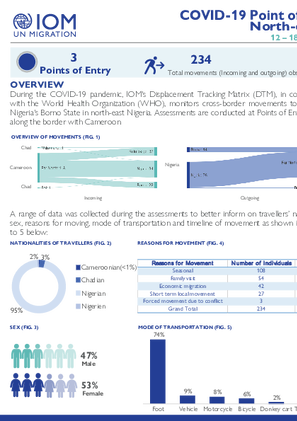-
Countries
-
Data and Analysis
-
Special Focus
-
Crisis Responses

Contact
DTM Ethiopia, SLOAddisAbabaDTM@iom.int
Language
English
Location
Ethiopia
Period Covered
Feb 01 2022
Feb 28 2022
Activity
- Flow Monitoring
In February 2022, a total of 18,683 movements were observed across five of Ethiopia's flow monitoring points (FMPs). It should be noted that data collection at Humera Flow Monitoring Point in Tigray region did not take place due to security and access constraints, thus affecting the total number of movements for the month. This represents an 6% increase in daily average movements in comparison with January 2022 when an average of 630 movements per day were observed.

Contact
DTM Mauritania, dtmmauritania@iom.int
Language
French
Location
Mauritania
Period Covered
Mar 07 2022
Mar 10 2022
Activity
- Mobility Tracking
- Event Tracking
- Village Assessment
Le suivi des situations d’urgence (en anglais, Emergency Tracking Tool, ETT) est une des composantes de la Matrice de suivi des déplacements (DTM) déployée par l’Organisation Internationale pour les Migrations (OIM). Il a pour objectif de recueillir des informations relatives aux déplacements causés par une crise ou des évènements soudains. Il offre une évaluation préliminaire d’une situation et permet de rapidement mettre en œuvre des mécanismes de réponse.
Le 05 mars 2022, suite à des attaques perpétrées par des individus armés dans la localité d’Attaye qui se trouve dans la commune de Dogofri (cerle de Niono, dans la région de Ségou au Mali), 857 familles d’éleveurs mauritaniens (4 426 individus) ont fui la commune et sont retournées, de manière préventive et par crainte d'attaques subséquentes, vers les villages de Likhleyil, Rkhoukha, Echleiba, Kervi, Teydouma et Seredouba en Mauritanie.
Les informations ont été collectées auprès d’informateurs clés (représentants de retournés, comités villageois) au moyen d’un questionnaire structuré axé sur les déplacements et les besoins humanitaires multisectoriels.

Contact
DTM Nigeria, AllUsersInDTMNigeria@iom.int
Language
English
Location
Nigeria
Period Covered
Mar 14 2022
Mar 20 2022
Activity
- Event Tracking
- Mobility Tracking
The DTM Emergency Tool (ETT) is deployed to track and to collect information on large and sudden population movements, provide frequent updates on the scale of displacement and quantify the affected population when needed. As a sub-component of the Mobility Tracking methodology in Nigeria. ETT utilises direct observation and a broad network of key informants to capture best estimates of the affected population per location, enabling targeted humanitarian response planning.
Between 14 and 20 March 2022, a total of 2,422 movements were recorded in Adamawa and Borno States. The recorded movements consisted of 2,053 arrivals and 369 departures. Arrivals were recorded at locations in Askira/Uba, Bama, Biu, Damboa, Gwoza, Hawul, Kala/Balge and Ngala Local Government Areas (LGAs) of the most conflict-affected state of Borno and in Fufore, Girei, Gombi, Hong, Lamurde, Maiha, Michika, Mubi South, Song, Yola North and Yola South LGAs of Adamawa State.
Departures were recorded in Askira/Uba, Bama and Gwoza LGAs of Borno State and in Fufore, Gombi, Hong, Maiha, Michika, Mubi North, Mubi South, Song, Yola North and Yola South LGAs of Adamawa State. ETT assessments identified the following movement triggers: voluntary relocation (843 individuals or 35%), poor living conditions (522 individuals or 22%), conflicts/attacks (459 individuals or 19%), military operations (341 iindividuals or 14%), improved security (186 individuals or 8%), fear of attacks (37 individuals or 1%) and seasonal farming (34 individuals or 1%).

Contact
DTM Yemen, iomyemendtm@iom.int
Language
English
Location
Yemen
Period Covered
Mar 13 2022
Mar 19 2022
Activity
- Rapid Emergency Registration
- Mobility Tracking
IOM Yemen DTM’s Rapid Displacement Tracking (RDT) tool collects data on estimated numbers of households forced to flee on a daily basis from their locations of origin or displacement, allowing for regular reporting of new displacements in terms of estimated numbers, geography, and needs. It also tracks returnees who returned to their location of origin.
From 01 January 2022 to 19 March 2022, IOM Yemen DTM tracked 4,556 households (HHs) (27,336 Individuals) have experienced displacement at least once.
Between 13 and 19 March 2022, IOM Yemen DTM tracked 205 households (1,230 individuals) displaced at least once. The majority of people moved into/within the following governorates and districts:
- Taiz (64 HHs) – Jabal Habashi (60 HHs), Al Makha (3 HHs), Al Qahirah (1 HH) and other districts. Most displacements in the governorate were internal.
- Al Hodeidah (59 HHs) – Hays (49 HHs), Al Khukhah (10 HHs) districts. Most displacements in the governorate were internal.
- Marib (36 HHs) – Marib City (20 HHs), Marib (11 HHs), Harib (5 HHs) districts. Most displacements in the governorate originated from Marib with 47 percent arriving from nine other governorates.
The majority of people moved from the following governorates and districts:
- Taiz (75 HHs) – Jabal Habashi (60 HHs), Maqbanah (6 HHs), Sharab Ar Rawnah (2 HHs) and other (7 HHs) districts.
- Al Hodeidah (63 HHs) – Hays (37 HHs), Jabal Ras (10 HHs), Al Jarrahi (6 HHs) and other (10 HHs) districts.
- Marib (19 HHs) – Harib (9 HHs), Jabal Murad (4 HHs), Marib City (3 HHs) and other (3 HHs) districts.
Contact
DTM Yemen, iomyemendtm@iom.int
Location
Yemen
Activity
- Event Tracking
- Mobility Tracking
Period Covered
Mar 13 2022 -Mar 19 2022
From 01 January 2022 to 19 March 2022, IOM Yemen DTM tracked 4,556 households (HHs) (27,336 Individuals) have experienced displacement at least once.
Between 13 and 19 March 2022, IOM Yemen DTM tracked 205 households (1,230 individuals) displaced at least once. The majority of people moved into/within the following governorates and districts:
• Taiz (64 HHs) – Jabal Habashi (60 HHs), Al Makha (3 HHs), Al Qahirah (1 HH) and other districts. Most displacements in the governorate were internal.
• Al Hodeidah (59 HHs) – Hays (49 HHs), Al Khukhah (10 HHs) districts. Most displacements in the governorate were internal.
• Marib (36 HHs) – Marib City (20 HHs), Marib (11 HHs), Harib (5 HHs) districts. Most displacements in the governorate originated from Marib with 47 percent arriving from nine other governorates.
The majority of people moved from the following governorates and districts:
• Taiz (75 HHs) – Jabal Habashi (60 HHs), Maqbanah (6 HHs), Sharab Ar Rawnah (2 HHs) and other (7 HHs) districts.
• Al Hodeidah (63 HHs) – Hays (37 HHs), Jabal Ras (10 HHs), Al Jarrahi (6 HHs) and other (10 HHs) districts.
• Marib (19 HHs) – Harib (9 HHs), Jabal Murad (4 HHs), Marib City (3 HHs) and other (3 HHs) districts.
Population Groups
Survey Methodology
Unit of Analysis Or Observation
Type of Survey or Assessment
Keywords
Geographical Scope
Administrative boundaries with available data
The current dataset covers the following administrative boundaries

Contact
DTMMozambique@iom.int
Language
English
Location
Mozambique
Period Covered
Mar 23 2022
Mar 23 2022
Activity
- Event Tracking
- Mobility Tracking
Recent movements of Non-State Armed Groups (NSAGs) have been reported in Mueda district. As of 23 March, observed presence of NSAGs in Mocimboa do rovuma and Naida areas triggered four large IDP arrival movements recorded in Namaua, Natsenge and Ngapa. An estimated 634 individuals have arrived in host communities and displacement sites of Imbuo and N'gapa posto. From the total individuals reported 33 have been identified with vulnerabilities: 24 elderly individuals and 9 pregnant women.

Contact
DTMMozambique@iom.int
Language
English
Location
Mozambique
Period Covered
Mar 16 2022
Mar 22 2022
Activity
- Event Tracking
- Mobility Tracking
During the reporting period (16 to 22 March 2022), a total of 42 movements were recorded - 35 Arrivals (1,348 individuals), and 7 departures (491 individuals). The largest arrival movements were recorded in Nangade (723 individuals), Mueda (457 individuals), and Montepuez (63 individuals). The largest departures were observed in Ancuabe (276 individuals) and Nangade (167 individuals). Of the total population, 73 per cent of the mobile groups were displaced for the first time, and 27 per cent of reported to having been displaced more than once prior to this movement.

Contact
DTM Nigeria, AllUsersInDTMNigeria@iom.int
Language
English
Location
Nigeria
Period Covered
Mar 14 2022
Mar 20 2022
Activity
- Event Tracking
- Mobility Tracking
Nigeria's north-central and north-west zones are afflicted with a multidimensional crisis rooted in long-standing tensions between ethnic and religious groups and involves attacks by criminal groups and banditry/hirabah (such as kidnapping and grand larceny along major highways). During the past years, the crisis has accelerated because of the intensification of attacks and has resulted in widespread displacement across the region.
Between the 14th and 20th of March 2022, armed clashes and banditry have led to new waves of population displacement. Following these events, rapid assessments were conducted by DTM (Displacement Tracking Matrix) field staff to inform the humanitarian community and government partners, and enable targeted response. Flash reports utilise direct observation and a broad network of key informants to gather representative data and collect information on the number, profile and immediate needs of affected populations.
During the assessment period, the DTM identified an estimated 4,216 individuals who were affected by the attacks. A total of 4,189 individuals were displaced to neighbouring wards in the LGAs Bukkuyum and Talata Mafara in Zamfara State, Wurno in Sokoto State, Kachia in Kaduna State and Gwer West in Benue State. A total of 65 casualties were reported, including 36
injuries and 27 fatalities.

Contact
DTM Nigeria, AllUsersInDTMNigeria@iom.int
Language
English
Location
Nigeria
Period Covered
Mar 12 2022
Mar 18 2022
Activity
- Mobility Tracking
- Baseline Assessment
- Points of Entry (PoE)
During the COVID-19 pandemic, IOM's Displacement Tracking Matrix (DTM), in collaboration with the World Health Organization (WHO), monitors cross-border movements to and from Nigeria's Borno State in north-east Nigeria. Assessments are conducted at Points of Entry located along the border with Cameroon.
A range of data was collected during the assessments to better inform on travellers’ nationalities, sex, reasons for moving, mode of transportation and timeline of movement as shown in figures 2 to 5 below.

Contact
DTM Djibouti, DTMDjibouti@iom.int
Language
French
Location
Djibouti
Period Covered
Feb 01 2022
Feb 28 2022
Activity
- Survey
- Flow Monitoring Survey
- Flow Monitoring
- Migrants presence
Pendant le mois de février 2022, 15 242 mouvements ont été observés aux points de suivi des flux (Flow Monitoring Points, FMP) à Djibouti, soit une moyenne journalière de 544 mouvements. Les flux migratoires ont augmenté de 20 pour cent par rapport au mois de janvier 2022, pendant lequel 454 mouvements avaient été observés en moyenne chaque jour. Cependant, ils n’ont pas encore atteint les niveaux observés pendant la période antérieure à la pandémie de COVID-19 (entre mars 2019 et mars 2020, la moyenne journalière était de 621).
